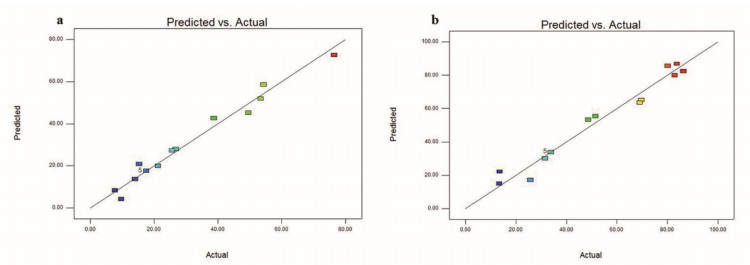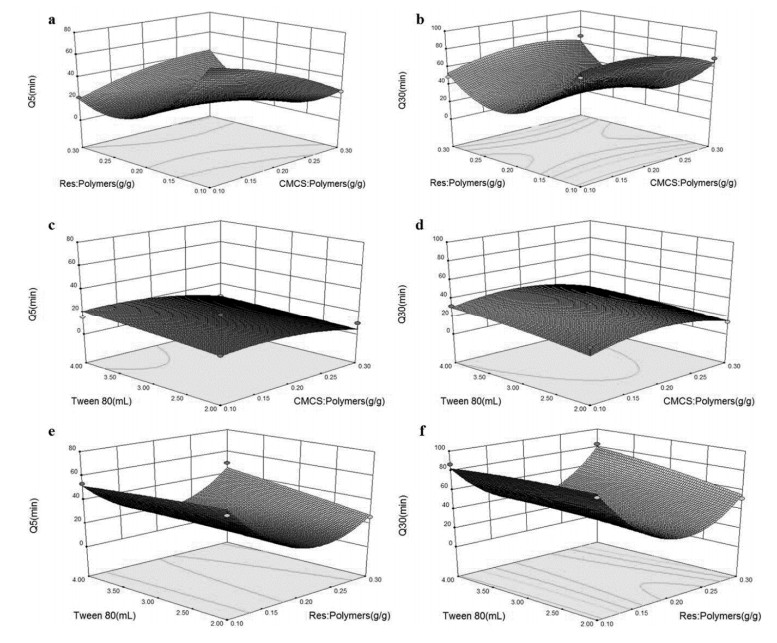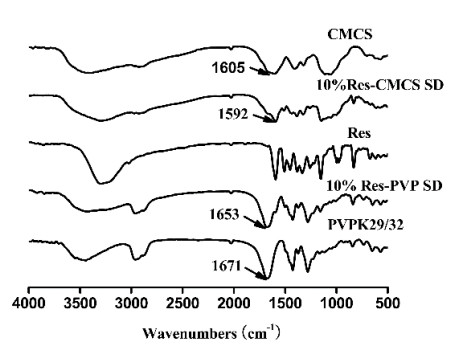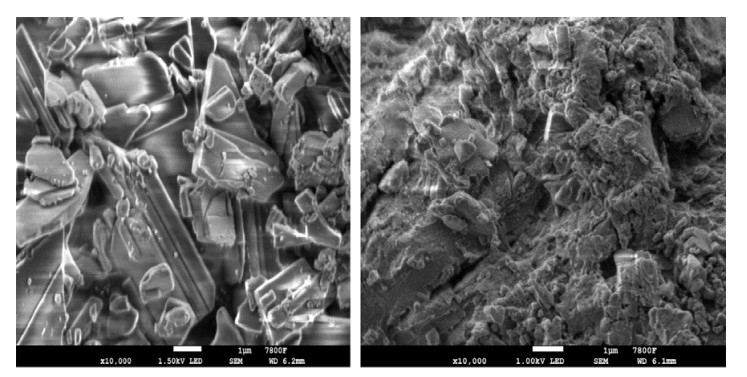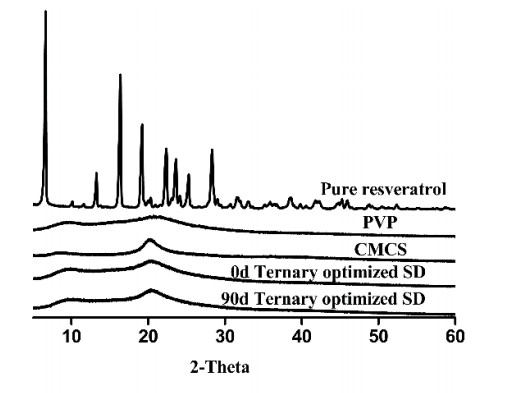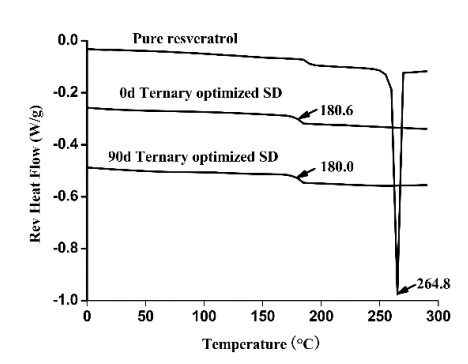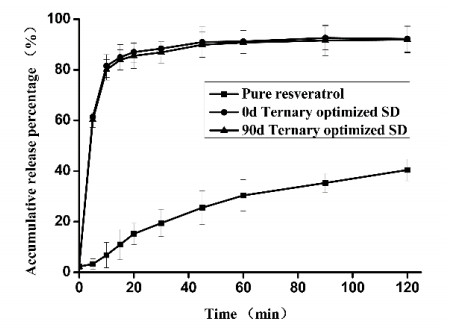1.
Introduction
The poor water solubility of drugs is one of the main challenges of drug delivery. According to reports, almost 70% of new drugs have water solubility challenges and consequently low oral bioavailability and delivery problems [1]. These drugs are classified as class Ⅱ according to the biopharmaceutics classification system (BCS) [2]. Many methods are used to improve the solubility of poorly soluble drugs and their bioavailability, such as chemical modification, micronization, solid dispersion (SD), pH adjustment, co-solvency, complexation, and micellar solubilization [3,4,5,6,7]. Among the various approaches, SDs are inexpensive, simple and advantageous [8]. It has been shown to be one of the most successful in improving the solubility and bioavailability of poorly soluble active pharmaceutical ingredients [9].
Resveratrol (Res, Figure 1) is a natural active ingredient produced in certain plants [10]. Numerous clinical trials have revealed that Res could help prevent or treat the main threats to health, such as cancer, hypertension and heart disease [11,12]. These tests clearly demonstrated the safety of Res. However, the poor oral bioavailability of Res was also confirmed [13]. The aqueous solubility of Res is low (30 µg/mL) at the pH of the small intestine (6.8). In contrast, Res is highly capable of infiltrating enterocytes. Therefore, it has important implications for exploiting delivery systems to improve the solubility and bioavailability of Res [14,15]. Hydrophilic carriers can increase drug dissolution due to improved wettability, solubility and dispersibility [16]. In the previous literature, various SDs of Res were reported for improving its dissolution using various carriers [17,18,19]. However, SDs of a single carrier presented some drawbacks in terms of formulation, physicochemical properties and physical and chemical stabilities of the vehicle and drug [20,21,22]. An appropriately designed or selected polymer can form a miscible amorphous dispersion with the drug [23]. Therefore, the purpose of this paper is to develop a binary polymeric blend with physicochemical properties and physical and chemical stabilities that meet these requirements. In this study, the use of a polymeric system containing polyvinyl pyrrolidone (PVP) and carboxymethyl chitosan (CMCS) (Figure 1) to improve the dissolution rate of Res has not been reported. CMCS is widely used for biomedical applications because of its good solution, biocompatibility, biodegradability, nontoxicity, and wide availability in Nature. PVP is an amorphous polymer with high water solubility. Both CMCS and PVP contain a carbonyl group (C = O), which forms hydrogen bonds with the hydroxyl group in Res. Hydrogen bonding interactions between polymers and drugs could improve the chemical and physical stability of their SDs [24,25,26]. Our hypothesis is that CMCS and PVP copolymers can protect the Res from recrystallization by hydrogen bonding interactions and maintain the high solubility of the Res. The main purpose of this study is to optimize and evaluate amorphous ternary SDs. We adopted a novel polymeric system that includes PVP, CMCS and Res to improve the dissolution rate and stability of Res SDs.
It is very important for pharmaceutical scientists to design formulations with the smallest number of experiments. A Box–Behnken design was used for the 3-factor and 3-level tests. The optimal process conditions were obtained by regression analysis of response surface methodology (RSM). Box–Behnken design involves the generation of multiple quadratic equations and mapping of the response over the experimental domain to select the optimum formulation [27]. In recent years, many pharmaceutical scientists have used it to design formulations [28,29,30]. In this study, Box–Behnken design was applied to optimize ternary SDs. Independent variables, including CMCS% (X1), Res% (X2), Tween 80 (X3), and their independent and joint effects on Res dissolution were evaluated at 5 minutes (Q5) and 30 minutes (Q30).
2.
Materials and methods
2.1. Materials
Plasdone (poly (vinyl pyrrolidone)) PVPK29/32 was obtained from Ashland Inc. (KY, USA). Carboxymethyl chitosan (CMCS) was purchased from Qingdao Honghai Biotechnology Co., Ltd. (Qingdao, China). Prior to use, PVP and CMCS were dried in a desiccator over powdered phosphorus pentoxide for at least one week. trans-Resveratrol (99%, batch number #111535-202003) from the National Institutes for Food and Drug Control (Beijing, China) was used as a standard. Res was purchased from Hainuo Chemical Company (Shanghai, China). Tween 80 was obtained from Sinopharm Chemical Reagent Co., Ltd. (Shanghai, China). Copper chloride was purchased from Tianda Chemical Company (Tianjing, China). HPLC grade acetonitrile and methanol and analytical grade ethanol and methanol were obtained from Shanghai Macklin Biochemical Co. (Shanghai, China).
2.2. Methods
2.2.1. Box–Behnken experimental design
Box–Behnken design was performed and statistically analysed using Design Expert software (Version. V8.0.6.1, Stat-Ease Inc., Minneapolis, MN). Single-factor tests were used to ensure that CMCS%, Res% and surfactant were the main factors influencing Res release. To find the optimized amount of carrier used in the SD formulation, independent and dependent variables are listed in Table 1. The polynomial equation was:
where Yi is the dependent variable; b0 is the intercept (arithmetic mean response of 17 runs); b1 to b33 are the regression coefficients; and X1, X2 and X3 are the independent variables that were selected from the preliminary experiments. The main effects of (X1, X2 and X3) represent the average result of changing one factor at a time from its low to high values. The interaction terms (X12, X23 and X13) show how the response changes when two factors are simultaneously changed. All the batches were prepared according to the experimental design in Table 2.
2.2.2. Preparation of SDs
SDs for all 17 batches were prepared by solvent evaporation. Crystalline Res was dissolved in ethyl alcohol, and then PVP was added to the Res solution. CMCS was added to the solution after the PVP was completely dissolved. After all mixtures formed uniform one-phase solutions, the solvent was removed using a rotary evaporator apparatus (RE-52C, Henan, China) by keeping the solution in a water bath (40 ℃). The SDs were then dried in a vacuum oven (DZF-6050, Shanghai, China) for 24 h. To reduce the particle size, solid dispersions were ground by a mortar with a pestle and sifted by sieve no. 70. The SDs were stored in a desiccator over powdered phosphorus pentoxide before use.
2.2.3. Examination of hydrogen bonding interactions
FTIR spectra were obtained using a Bruker Vector 22 (Bruker Optik GmbH, Ettlingen, Germany). KBr pellets of each Res alone and SDs were prepared. All spectra were obtained at a resolution of 4 cm-1, and 64 scans were added.
2.2.4. Scanning electron microscopy (SEM)
To examine the morphology of SDs in the dry state, samples were analysed by SEM (JSM-7800F, JEOL, Japan) at a working distance of 6.2 mm. The particles were observed to determine the surface characteristics.
2.2.5. Stability studies
The optimized ternary SDs were placed in weighing bottles without caps and charged for accelerated stability studies for a period of 3 months in ovens set to 40 ± 2.0 ℃ (668, Dalian, China). A saturated copper chloride solution was used to supply the 69 ± 5% RH. The samples were withdrawn after 90 days and evaluated for their solid-state and in vitro Res release.
2.2.6. Modulated differential scanning calorimetry (MDSC) measurements
The MDSC study was performed. The MDSC (Q1000, TA Instruments, New Castle, DE, USA) was equipped with a liquid nitrogen cooling system. The samples were heated to 300 ℃ with modulations of ± 1 ℃/60 s at a 3 ℃/min heating rate under purged dry argon gas (50 mL/min) (n = 3).
2.2.7. X-ray powder diffraction (XRD)
XRD patterns were obtained using an X'Pert Pro-1 diffractometer (PANalytical Co., Almelo, the Netherlands) with Cu Kα radiation (λ = 1.5418 Å) at 40 kV and 40 mA. Samples were scanned from 5° to 50° 2θ at a scanning rate of 2°/min with a sampling interval of 0.02°.
2.2.8. In vitro release profile
Dissolution equipment (RC806, Tianjin, China) was used to determine the release rate of Res dissolution according to the paddle method (USPII method). Each quantity of SDs corresponding to 5 mg Res was placed in the apparatus. The test was performed under the condition of a rotation speed of 100 rpm at 37 ± 0.5 ℃. The dissolution medium consisted of 250 mL of dilute hydrochloric acid (Aladdin Reagent Co., Ltd), pH 1.2. At predefined time intervals, samples (1 mL) were removed from the dissolution medium, and an equal volume of fresh dissolution medium was added after the sample was withdrawn. Samples (1 mL) were filtered through 0.22 μm membranes. The content of Res was analysed by HPLC based on a calibration line of standards of known concentrations. HPLC analysis was performed with a C18 column (200 mm × 4.6 mm, 5.0 μm Kromasil, China) and a UV detector (Waters 2998PAD UV–vis spectrophotometer, USA). The injection volume was 20 μl. The samples were measured at a wavelength of 293 nm to detect Res by UV detection.
3.
Results
3.1. Data analysis in the Box–Behnken design
3.1.1. Data analysis for Y1 (Q5) and Y2 (Q30)
The observed values of Q5 (Y1) and Q30 (Y2) for all the batches are shown in Table 3. The Y1 and Y2 values from different batches showed a wide range of changes. The results clearly indicated that the Q5 and Q30 values were strongly affected by the selected variables. The responses (Y1 and Y2) obtained at various levels of the 3 independent variables (X1, X2, and X3) underwent multiple regression to yield second-order polynomial Equations (2) and (3) (full model), respectively. The equation clearly reflects a wide range of values for the coefficients.
The responses of the experimental values and predicted values are shown in Figure 2. Quadratic regression models of the ANOVA revealed that the response surface models of the three responses were obvious and appropriate (Table 4). In addition, the summary of the model results indicated that the R2 values of all the response models were greater than 0.9, which revealed good and reliable relevance between the actual and predicted responses. In addition, the values of the coefficient of variation were low (CV = 15.6 and 13.52%), indicating a precise and reliable experiment.
The interactions between independent variables and the dependent variables, the standardized effects of independent variables with the relative significance of independent variables and the main influence of the independent variables on Q5 and Q30 are summarized in Table 5. Among the 3 independent variables, X2 (Res%) had a prominent effect (b2 = -9.47 and P = 0.0005, b2 = -8.47 and P = 0.0082) on Q5 and Q30. X1 (CMCS%) moderately affected the results (b1 = 2.69 and P = 0.0096) from Q5 and minimally affected the results (b1 = -2.54 and P = 0.31) from Q30, suggesting that CMCS% has an insignificant effect on Q30 (P > 0.05). X3 (Tween 80) also had an insignificant effect on both Q5 and Q30 (P > 0.05). X1 and X2 negatively affected the Q5 and Q30 results.
3.1.2. Response surface analysis and contour plots
Three-dimensional response plots showed the behaviour of dissolution (% release at 5 min = Q5 and 30 min = Q30), the main effect, the squared effect (nonlinear) and the interactions between the two independent variables (Figure 3). From the three-dimensional response plots, CMCS% and Res%, Res% and Tween 80 had their individual effects on the three responses. CMCS% and Tween 80, and Res% and Tween 80 had a minimal effect on the three responses. It is well known that X1 and X2 negatively affect Q5 and Q30. The three-dimensional response plot clearly shows that at low levels of X1 and X2, Q30 > 80% can be achieved, but at least a medium level or higher is needed to achieve a higher Q5 and Q30 for X3.
3.1.3. Validation of response surface methodology
The predicted values of the response variables suggested that the prediction error varied between -3.04–12.20% and -0.5–3.99% for Y1 and Y2, respectively (Table 6). Thus, we concluded that Eqs (2) and (3) were valid for predicting Q5 and Q30. A correlation coefficient of linear correlation, R2, was 0.9772 and 0.9700 for the observed and predicted response variables of percentage Res release at 5 and 30 min, respectively, indicating excellent goodness of fit, as shown in Table 4.
3.2. Solid-state characterization of the optimized ternary batch
To verify the occurrence of hydrogen bonding between Res and the polymers, FTIR spectra were obtained (Figure 4). The presence of Res caused a significant shift in the C = O stretching of PVP from 1671 cm−1 to a lower wavenumber of 1653 cm−1 and CMCS (C = O stretching) from 1605 cm−1 to 1592 cm−1, indicating the absence of hydrogen bonding between Res and the polymers.
In the SEM report of the optimized ternary SD (Figure 5), the particles were relatively amorphous in comparison to pure Res because the Res was uniformly dispersed throughout the carrier molecules. Based on the SEM and FTIR data, we concluded that the Res was molecularly dispersed as amorphous nanoparticles in the polymers.
The XRD pattern showed that PVP and CMCS were amorphous chemical compounds (Figure 6). The sharp peaks of pure Res disappeared from the optimized ternary SDs, indicating the amorphous form of Res. The MDSC study indicated that the melting point of Res was 264.8 ℃. However, for amorphous SDs, no melting endotherm was observed, suggesting that no Res crystals were present in the SDs. A single glass transition temperature (Tg = 180.6 ℃) was observed with the 0-day samples (Figure 7).
3.3. Release profiles of optimized ternary SDs
A significant improvement in the dissolution rate profile of the optimized ternary SD batch was observed in comparison to pure Res in hydrochloric acid solution at pH 1.2 (Figure 8). Within 30 minutes, the ternary SD batch showed 88.38% release, while the Res showed only 19.42% release, indicating that the particle size decreased, and the lack of crystallinity increased the wettability of the Res in the solid dispersion.
3.4. Stability studies
The XRD pattern demonstrated that the optimized ternary SDs remained amorphous after 3 months (Figure 6). The MDSC results revealed that there was little change in Tg (180.0 ℃) under accelerated conditions (69 ± 5% RH and 40 ± 2 ℃) after 3 months (Figure 7). The cumulative release percentages at 5 and 30 min were > 60 and 86%, respectively, throughout the stability period (Figure 8). From the statistical study (Tukey test), it was clear that there was no significant difference in the accumulative release percentage, as P > 0.05 at the interval of study. Polymers are known to inhibit the recrystallization of drugs and thus maintain supersaturation of the drug in the dissolution fluid. All the results indicate that under accelerated conditions (40 ± 2 ℃ and 69 ± 5% RH), the optimized ternary SD powder was physicochemically stable over 3 months. In this case, the blend of PVP and CMCS was successful in enhancing and maintaining the supersaturation of the amorphous form of Res. Hence, the optimized ternary SD powder is sufficiently stable according to the regulatory requirements.
4.
Discussion
This study optimized the dissolution profile of Res by Box–Behnken design. The optimized formulation achieved CMCS% = 0.17 (X1 = -0.28), Res% = 0.1 (X2 = -1) and Tween 80 = 2.94 (X3 = -0.6). The experimental values of Q5 and Q30 in all 17 batches and check point batches showed good correspondence with the predicted values, indicating goodness of fit for the models. The dissolution of Res can be predicted by these models under the same dissolution conditions, which provides guidance for optimization of the formulation. In conclusion, CMCS is an enteric polymer that was successfully used in combination with PVP to produce SDs of poorly soluble Res. Ternary optimized SDs were characterized using SEM, FTIR, XRD, and thermal analysis techniques. Ternary SD powder exhibited excellent solubility, dissolution rate and physicochemical stability in comparison with pure Res. If this formulation is scaled up to the manufacturing level, amorphous SDs show more solubility and faster dissolution than their crystalline analogues and provide novel insights into the application of resveratrol. However, many long-term stability, clinical pharmacokinetic studies and preclinical toxicity studies are required before production and commercialization can occur. Over time, amorphous SDs might crystallize, which leads to decreased solubility and a lower dissolution rate of the drug. The use of more than one polymer for formulating SDs might help overcome the storage and stability issues and increase the commercial viability and success of SDs.
Acknowledgments
This work was supported by the Shandong College Students for innovation and entrepreneurship training program [grant numbers S202110455014] and the Natural Science Foundation of Shandong Province [grant numbers ZR2020MC199] and the Foundation [grant number ZZ20200121] of the State Key Laboratory of Biobased Material and Green Papermaking, Qilu University of Technology, Shandong Academy of Sciences.
Conflict of interest
The authors declare that they have no competing interests.
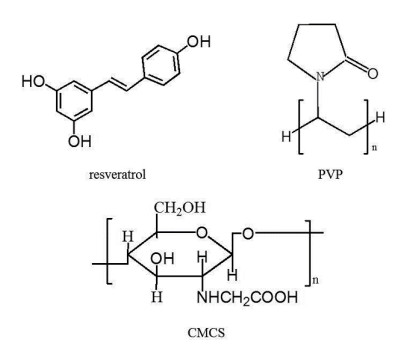









 DownLoad:
DownLoad:
